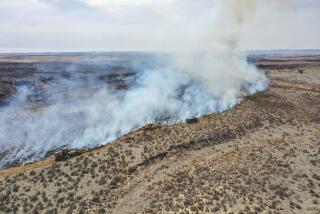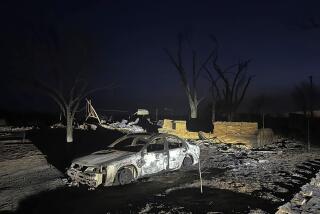Texas brings some blazes under control but fears new fires
Texas fire officials have brought some major blazes under control, allowing residents to return to their homes, but warned that the state may still face more fires given record summer heat and drought.
During the last week, firefighters across the state have responded to 176 wildfires that burned 126,844 acres, according to the Texas Forest Service.
The largest fire, in the Bastrop area east of Austin, has destroyed 1,386 homes, a state record for a single fire. Firefighters had the blaze 30% contained Thursday and expected to make headway in the coming days, but local officials warned that they could see more fires if hot, dry conditions persisted.
“I’m concerned that some yo-yo could throw a cigarette out north of Bastrop and light the place up,” said Bastrop Mayor Terry Orr. “We are far, far from being out of fire-stress danger — this is just a pause.”
Officials announced Thursday that Texas had set a national record for the hottest meteorological summer (June 1 to Aug. 31), with an average temperature of 86.8 degrees, beating a record set by Oklahoma in 1934 during the Dust Bowl.
Texas has been struggling with a record drought since July 2010, with levels of extreme and exceptional drought totaling nearly 96%, an increase from the previous week, according to a U.S. Drought Monitor report released Thursday.
“The drought is kind of feeding on itself at this point,” said Mark Svoboda, a climatologist at the National Drought Mitigation Center at the University of Nebraska in Lincoln. “We really need a tropical system to come in and bust it.”
It was unclear whether Tropical Storm Nate would provide such relief.
Nate, which was hovering over the Gulf of Mexico, might head to Texas next week, but it is too soon to say whether it would help douse or fan the fires. When Tropical Storm Lee rolled in last weekend, it brought Texas more wind than rain, exacerbating wildfires.
“Nate could either be a godsend or a curse, depending on what the track will be,” said Victor Murphy, a meteorologist with the National Weather Service in Fort Worth. “Texas is in a very perilous situation. We’re in uncharted waters.”
The U.S. Forest Service has sent 1,628 personnel to aid state and local firefighters, including 765 fire personnel from California.
The agency also dispatched a DC-10 water tanker from California to Austin late Tuesday. It was expected to be used Friday once a pilot became available.
Forest Service officials provided aid to Texas even as they were preparing for lightning storms that are expected to strike Northern California forests this week, spokesman Stanton Florea said. California-based federal wild land firefighters have helped battle various Texas fires since February, he said.
Texas fire officials have contacted counterparts at the California Department of Forestry and Fire Protection to determine whether they would be willing to provide assistance, but have yet to make a formal request, said Ken Pimlott, the department’s director.
With U.S. Forest Service firefighters and equipment already in Texas, Pimlott said he also had to consider how much local forces were depleted.
“The more drawn down our federal partners are, both the state and local forces are going to have to pick up more of the responsibility,” he said. “We’re not going to leave California unprotected.”
But if Texas officials make a formal request, he said, the urgency may outweigh immediate needs in California.
“The state of Texas and other areas of the Southwest are really struggling to get resources,” he said. “Back in 2008, we got broad support. It works both ways.”
One person watching the fires from afar — and with great interest — was Mike Fossum. An astronaut aboard the International Space Station, he was raised in Texas and knows the Bastrop area well.
Nicole Cloutier, a spokeswoman for flight crew operations at Johnson Space Center in Houston, said Thursday that Fossum became familiar with the Bastrop area during trips he took there as a Boy Scout leader and from his years studying at nearby Texas A&M University.
On Thursday, as the space station flew directly over Bastrop, she said, Fossum was in a module, looking down.
“He could see the burn in the land,” Cloutier said. “It’s nearly impossible to see something like that and not be affected by it.”
molly.hennessy-fiske@latimes.com
More to Read
Start your day right
Sign up for Essential California for news, features and recommendations from the L.A. Times and beyond in your inbox six days a week.
You may occasionally receive promotional content from the Los Angeles Times.







